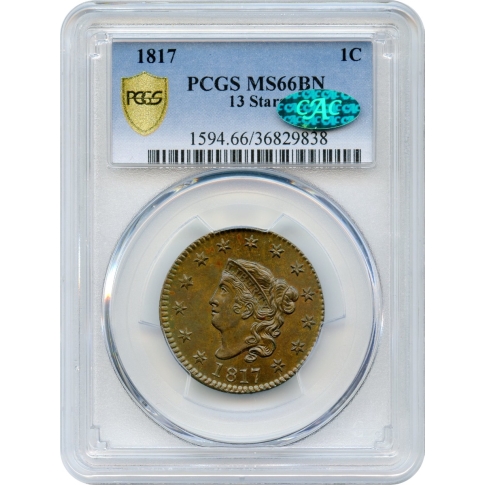1817 1C Coronet Head Large Cent, 13 Stars PCGS MS66BN (CAC)
Graded MS66BN by PCGS, you will not find a finer example of this coin. It is the top of the pop--there is none finer and tied with eleven (11) others. Plus, CAC has endorsed this coin as having much superior quality for the grade - one of three (3) to receive such acclaim. This is a registry coin, ready to be counted among the most important collections of Coronet Cents. Featuring a rich chocolate brown color and sharp strike, this true rarity will be a cherished addition to your collection. The discriminating numismatist will be proud to own this dramatic relic from America's storied past.
For the enthusiast of early American coppers, this is indeed an exciting offering from AUCM. It was in March of 1817 that James Monroe became the fifth U.S. president. The year 1817 also saw Alaska owned by Russia, while Florida and California still belonged to Spain. Mississippi became a state during that year. And, at the Philadelphia mint, the 1817 Coronet Head Large Cent was produced in the amount of 3,948,400. And out of that total mintage, PCGS has graded 850 of them in BN (in the 13 Stars type); and from among those 850 coins only 11 have been graded MS66BN.
The Coronet Head Large Cent was first produced in 1816. It was a redesign of the Classic Head Large Cent, designed by John Reich, that had been coined through 1814. In response to the criticism of the narrow headband worn by Liberty, chief engraver Robert Scot fashioned a new design that included changing the headband to a coronet. There has been some confusion over the name of this Large Cent type. Most online sources, including major third-party grading services, call it the "Coronet Head," while reference materials in print favor the name "Matron Head," which originated with members of the Early American Coppers Society.
There are two types of the 1817 Coronet Large Cent: "13 Stars" and "15 Stars." The reason for the 15 Stars version is not precisely known, however it has generally been attributed to the failing eyesight of Robert Scot. The story that has come down to us over the years is that on one die, the first six stars had been punched too close together, and therefore Scot added nine more in order to have a balanced appearance of the stars. This saved the die and consequently gave us the "15 Stars" variety.
Many collectors enjoy collecting Coronet Large Cents and the Early American Coppers Society was established in order to promote the study and collecting of such coins, among other copper coinage from America's past. However, there has been criticism of Robert Scot's designs, including the Coronet Head. An eloquent critique is presented by numismatic art scholar Cornelius Vermeule: "In 1816 Robert Scot...designed a new obverse for the cent. This Liberty, wearing an inscribed coronet, is a crude forerunner of the Roman Liberty that emerged on the gold coinage a generation hence and remained until Theodore Roosevelt modernized these coins in the first decade of the 20th century. The basic forms of a Greco-Roman Juno or Venus are presented in the new cent, but the face is ill-proportioned, the head is too square, and the early American penchant for long curling tresses is still manifest... the stars are inordinately large, and the head is poised in such a fashion as to appear about to tumble on its squashed, pseudoclassical nose."
| PCGS # | 1594 |
|---|---|
| Grading Service | NONE |
| Year of Issue | NONE |
| Grade | NONE |
| Denom Type | N/A |
| Numeric Denomination | 1C |
| Mint Location | NONE |
| Designation | NONE |
| Circ/UnCirc | Not Specified |
| Strike Type | N/A |
| Holder Variety | 13 Stars |
| Grade Add On | NONE |
| Holder Type | N/A |



